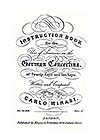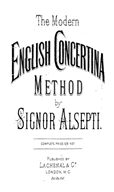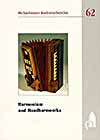Instruction Book for the Use of
Learners of the German Concertina, of Twenty Keys and Ten Keys.
(London: Kleyser & Tritschler, 405 Oxford Street, 1846.)
by Carlo Minasi
This tutor by Carlo Minasi, published in London in 1846, as well as another tutor published
about that same year in America by Elias Howe, Jr., are the earliest known English-language publications for German
or Anglo-German concertina. (The date for Minasi’s publication is taken as the date of accession
in the Integrated Catalogue of the British Library, which
is given as 1846.)
Carlo Minasi (1817–1891) produced more than forty tutors and tune books for English and Anglo concertina
and other instruments, a vast array of sheet-music arrangements for English concertina and other
instruments, and Minasi’s Concertina Journal 1-6 (from 1858 onward).
The German concertina flourished in Victorian England, as well as in Germany, Poland, America,
and many other locations, because of its intuitive ease of playing and its low cost.
These imported German instruments were simple and clumsy, but in the hands of artists like Minasi and George
Jones (whose 1876 tutor is also available in full on this site),
they were being pushed to the max.
Builders of English system concertinas, seeing this potential, soon began building higher quality instruments,
known as “Anglo-German” concertinas or just “Anglos”, by combining the German system
with the superior mechanical design and engineering already applied to English concertina.
Development of Playing Techniques
The first Anglo-type concertinas in England were one- and two-row instruments imported from Germany.
These first “German” concertinas arrived in London at least by the mid-1840s. Many regarded them as mere toys;
they were cheaply made and had wooden levers and cardboard bellows (fittingly, the publisher of
Minasi’s tutor, the firm of Kleyser & Tritschler dealt in German toys and clocks).
However, early German concertina makers such as Johann Gottlieb Höselbarth published tutors
for their instruments that showed the powerful attributes of this instrument for chorded
accompaniment (Höselbarth’s German-language
tutor, circa 1837, is included elsewhere on this site).
Minasi—an accomplished musician, teacher, and composer—learned from the work of these
German contemporaries and, like them,
saw much more potential in this humble
instrument. He also promoted the instrument as easy to
learn: “The German Concertina is confidently recommended as an instrument of much power and variety,
and one upon which great execution can be attained with comparatively little practice”. For the convenience
of his readers, he included “medallions” to cut out and paste on the instrument to label the keys.
This publication, however, goes well beyond the basics; in it are instructions
not only for the simple “along the row” melody line style, but also for octave
playing, cross-row fingering, and chord accompaniment. On cross-row fingering, Minasi showed the
greater efficiency of using both rows of his two-row instrument when playing in a single key; his claim was
that cross-row fingering was “intirely [sic] new, and introduced by the Author who
has found it not only better to use the different … keys (giving the same note), but it enables him
to Modulate as well as to arrange almost any music to the Instrument with good effect”. For example,
he used cross-row fingering for octave playing (playing notes simultaneously that are one octave apart),
showing that the octave scale of C is better accomplished by playing the first four notes on the C row
and the last four notes on the G row, rather than playing it all on one row (p. 11). He also
demonstrated that the octave scale in C can be further refined to eliminate some of the bellows changes.
Minasi was using cross-row fingering not only for speed, but to better enable the fitting of
chords to melody, and it is in harmonic treatment where Minasi puts his main emphasis. Following
a general and extensive set of chord exercises, he provides numerous fully arranged musical selections.
These arrangements are almost all in the so-called “English” or “harmonic” style, where chords are played on the
left and melody on the right, more or less as a duet concertina is played.
His first two tunes in this tutor, “No. 1” (p. 13) and “God Save the Queen” (p. 14),
are taken directly from Höselbarth, without attribution
(see Höselbarth’s tutor for discussion).
It is not known which of the other arrangements may have been similarly ‘borrowed’, but
presumably many of the tunes with British roots (e.g., “Rule Brittania”) were arranged
by Minasi. The simple arrangement of
“God Save the Queen” is notable for its interesting chords; these chords are not as plain as one might
expect, especially since the tune is played entirely on the C row.
There are many other fully arranged selections in the harmonic style,
including waltzes and “Scotch” tunes (schottisches); Minasi,
like his German contemporaries, was already promoting the Anglo for ‘traditional’ dance music.
Anglo players will note the clear use of an ‘oom-pah’ accompaniment in a waltz (p. 17) and
the first “Scotch” piece (p. 18). Oom-pah chords provide much of the characteristic rhythm of modern
Morris music.
Pitch and Keys of Early Instruments
In studying Minasi's tutor, the twenty-key instrument can be understood just like later two-row Anglos.
There is one row in C and one row in G, which is how the keys are labeled and how the music is written.
Minasi's notation is a bit unexpected, however; on the key layout, notice that
"Press" is written above "Draw" for the left hand,
whereas "Draw" is written above "Press" for the right hand.
Understanding the ten-key instrument requires close attention to detail.
The notes on the 10-key diagram are labeled with the same note-names
used for the C-row on the twenty-key, but it does not play the same pitches;
instead of beginning on C, it starts on E, so
if you play it with the fingering intended for the C-row (what Minasi calls "tuned in C") you will be playing in the key of E.
The notation used on the "medallions" for the ten-key has been simplified (perhaps because the publishers knew
that too many accidentals are bad for business).
The scale on the ten-key, since it starts on E (Press on middle key, left side),
should include four sharps: C#, D#, F#, and G# (the buttons should be labeled using the note-names E, F#, G#, A, B, C#, D#, E).
But in the tutor, all four sharp signs (#) are simply omitted, and the buttons are labeled using "D", "F", "G", and "C".
Omission of the notation for the sharps is true for the ten-key only; three of the twenty-key buttons are labeled F#,
because that is required to distinguish
F# in the lower (G) row from F in the upper (C) row of the twenty-key.
As long as you realize that the buttons on the ten-key diagram have been
labeled in this manner, there should be no further mysteries.
In the button layouts, the twenty-key is notated in the keys of C/G, and the ten-key is shown in E.
Minasi gives us an unexpected insight (p. 6) into the actual pitches produced by the instruments.
He explains that all these are what would now be called "transposing" instruments and that they sound
three half-tones (a “minor third”) lower than what the notation would indicate;
the notes on the "C" and "G" rows of the twenty-key instrument are heard as being in the keys of A and E,
and the notes on the "E" row of the ten-key are heard as being in the key of C#.
These lower pitches are what a player needs to know for playing with other instruments.
Based on the pitches produced, these twenty-key and ten-key concertinas would be described today
as being in A/E and in C#, respectively.
We don't know whether this particular transposition was a characteristic of just these specific Kleyser &
Tritschler instruments, or possibly was more widely used. Minasi does not indicate that the concertinas
he is describing are unusual, but perhaps his tutor was intended to accompany instruments from just one source.
What we do know is that these were not the only concertinas that produced pitches different from the notation used for them.
At least two authors of other German concertina tutors writing in the early 1850s mentioned this same fact.
First, the author of New Work for the Concertina … With Directions for Playing and a Variety of Popular
Airs (Glasgow: John Cameron, c. 1850 and 1883),
entry A58 in Merris’s
bibliography:
SCALE OR KEY. It will be observed, by the following scales, that the principal key in which the
GERMAN CONCERTINA plays is in the key of C; and although, from a difference of pitch that sometimes
occurs in one from another, it may not strictly be the key of C as played on the Piano-forte or
other instrument; it is however, assumed to be the key-note … .
A similar commentary appears in Albert W. Coleman, Coleman’s New Instructions for the German
Concertinas (London: W. Coleman, 1854),
entry A102 in Merris’s
bibliography:
In consequence of many persons making objections relative to these Instruments varying in pitch,
and supposing music must be written in a particular key to which the Instrument is tuned; it may
be as well to observe that the Airs are written in the Key of C, and therefore C is assumed to be
the Key Note, whatever may be the real pitch of the Instrument.
Other tutors for German and Anglo-German concertina written in this same period, as well as those
that followed, made no mention of a difference in actual pitch but
simply used, without comment, diagrams with the modern type of twenty-key C/G layout. Diagrams for the ten-key
are scarce, since production of the smaller instrument pretty much died out, but where a ten-key
diagram is given it has the same layout as the C row of a twenty-key—save in an occasional tutor such
as Juliana’s (entry E32
in Merris’s bibliography) which appears to have borrowed Minasi’s illustration without explanation.
The fact that English-language tutor writers became unconcerned about this matter suggests that
a standard of C/G tuning for the notes actually heard on the twenty-key concertina emerged,
at least for German concertinas imported to England and for the Anglo-German concertinas produced there,
so that the instruments matched the notation. Though C/G became standard for twenty-key (and later thirty-key) concertinas,
instruments in other tunings (most commonly Ab/Eb, G/D, and Bb/F) have been available up to the
present day, but instruments in A/E like the ones Minasi describes are uncommon.
(We would like to thank Stephen Chambers and Robert Gaskins for comments received in response to our earlier drafts of this note.)
Read or Download the Whole Document in a Single File
Authors
Randall C. Merris
(
)
is an economist at the
International Monetary Fund and an amateur Anglo concertinist. He has been an
economist at the Federal Reserve Bank of Chicago; has taught economics and
finance in the Kellogg Graduate School of Management, Northwestern University;
and has consulted with Asian governments on economic policy and financial
reform. He writes mainly on economics and occasionally on the concertina and
its history.
Dan Worrall
(
)
has played the Anglo and English concertinas for over thirty years, as an amateur hobbyist.
He is the author of The Anglo Concertina Music of William Kimber, published by the
English Folk Dance and Song Society in 2005.
His current interests include studying various styles of Anglo playing as well as learning
the art of concertina construction. An earth scientist by training, he holds a Ph.D.
in geology from The University of Texas at Austin. He recently retired from a career
in petroleum exploration and research, and lives with his wife on a farm in the Brazos
River valley of southeastern Texas, where he raises cattle and is an avid gardener.
They have two children.





























